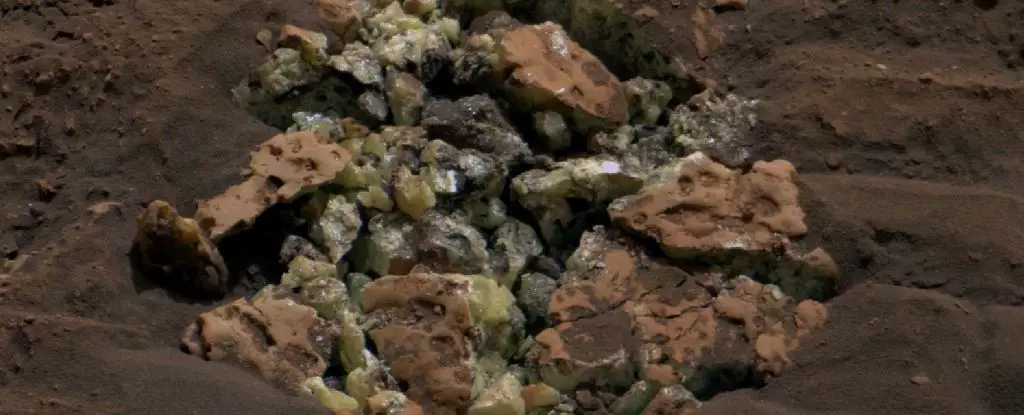The discovery of pure elemental sulfur on Mars by the Curiosity rover has sent ripples of excitement through the scientific community. In May, as the rover made its habitual explorations, it inadvertently cracked open a seemingly inconspicuous rock. What emerged from this small geological incident was nothing less than a vibrant cache of yellow sulfur crystals. This finding is particularly groundbreaking, as it marks the first occasion that sulfur has been documented in its elemental form on the surface of the Red Planet. This unexpected revelation not only highlights the complexities of Martian geology but also opens new avenues for understanding the planet’s historical environmental conditions.
Curiosity’s exploration of the Gediz Vallis Channel sets the stage for this monumental discovery. The region is dotted with rocks that bear a resemblance to the sulfur-laden specimen, hinting at the possibility of abundant sulfur deposits in that area. Ashwin Vasavada, the project scientist for Curiosity at NASA’s Jet Propulsion Laboratory, described the finding as akin to “discovering an oasis in the desert.” This analogy underscores the contradictions of Mars, a planet long perceived as barren and devoid of life. Such discoveries are crucial; they fuel the quest to solve the mysteries surrounding Mars’ geological evolution and its potential to harbor life.
Understanding the significance of sulfur in Martian geology is essential for grasping the implications of this discovery. Sulfates, often found on Mars, form when sulfur interacts with water and other minerals. This process occurs through evaporation, resulting in the deposition of sulfate minerals which can provide key insights into the planet’s water history and climatic changes. However, the existence of pure sulfur suggests something unique and exceptional. Unlike sulfates, elemental sulfur requires very specific environmental conditions to form, which, according to current geological models, do not readily exist in the Gediz Vallis region.
The finding invites questions about the history of the planet. How did this sulfur remain in its elemental form? This question beckons scientific attention, as understanding the conditions that allowed for such a phenomenon would necessitate a deeper investigation into Mars’ geological evolution. The implications are profound; elemental sulfur could suggest previous conditions favorable to life or at least to the chemistry necessary for life to thrive.
Sulfur is not just a curious mineral; it plays a pivotal role in biochemistry and is an essential element for life as we understand it. Most living organisms utilize sulfur in the form of sulfates to synthesize amino acids, which are crucial for building proteins. Although sulfates have been identified on Mars prior to this discovery, pure sulfur introduces a new layer of complexity. It suggests that the planet might have, at some point, hosted environments more conducive to life than previously believed.
While the ongoing search for signs of life on Mars has yet to yield definitive evidence, the detection of crucial chemical elements enhances our understanding of the planet’s potential for habitability. Elements that could support biological processes, combined with historical evidence of water, offer tantalizing hints about Mars’ past. This discovery galvanizes the field of astrobiology, pushing scientists to consider not only Mars’ ancient conditions but also the broader implications for life beyond Earth.
As Curiosity forges onward through the Gediz Vallis Channel, the journey is far from over. The rover’s capabilities extend beyond mere observation; its instruments are conducting detailed analyses of the geological samples retrieved. By drilling into Martian rocks, Curiosity is poised to unravel more of the planet’s narrative, hoping to unveil further surprises nestled within.
The initial findings of pure sulfur have set the stage for a comprehensive investigation into Mars’ geological past. Future missions, including potential human exploration, will benefit from the foundational knowledge gained through these robotic endeavors. Understanding the conditions that allowed for pure sulfur will be pivotal, and researchers are fully aware that the road to unlocking the mysteries of Mars will involve meticulous analysis and perhaps even the development of new geological models.
As we piece together the geological puzzle of the Red Planet, each discovery brings us closer to comprehending its marvels. The presence of elemental sulfur is not just a rock; it is a beacon of potential insights into Mars’ rich and complex history. Scientists around the globe continue to watch as Curiosity and future missions venture forth into the unknown, eager to discover what other treasures await beneath the Martian surface.


Leave a Reply